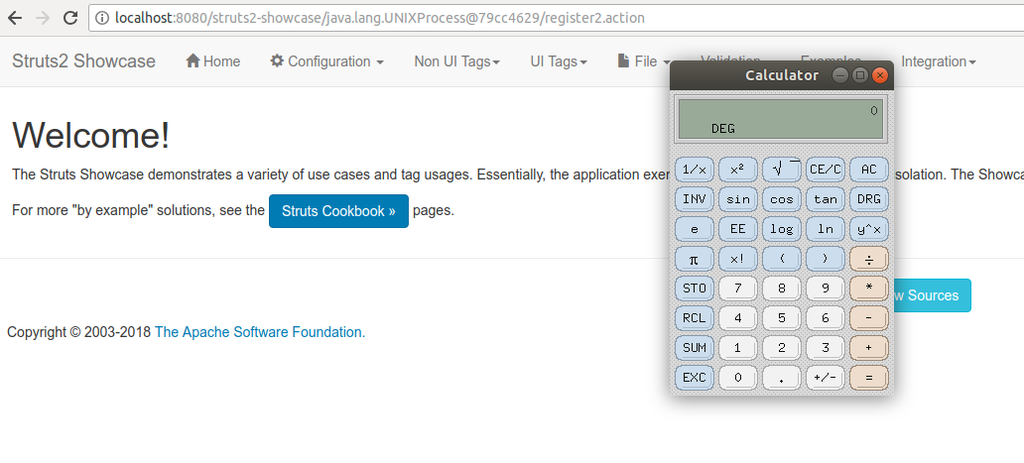概述
定义XML配置时如果namespace值未设置且上层动作配置(Action Configuration)中未设置或用通配符namespace时可能会导致远程代码执行。
url标签未设置value和action值且上层动作未设置或用通配符namespace时可能会导致远程代码执行。
官方解决方案
升级至版本2.3.35或2.5.17。这两个版本仅仅只是更新了安全补丁,不存在兼容性问题。
临时解决方案
推荐用户及时更新,但如果不想更新,可暂时使用官方提供的临时解决方案:当上层动作配置中未设置或使用通配符namespace时,验证所有XML配置中的namespace,同时在JSP中验证所有url标签的value和action。
|
影响范围 |
所有Struts2开发者及用户 |
|---|---|
|
漏洞影响 |
有可能会导致远程代码执行 |
|
最高安全风险 |
关键 |
|
推荐防护措施 |
更新至2.3.35或2.5.17 |
|
影响版本 |
Struts 2.3 – Struts 2.3.34, Struts 2.5 – Struts 2.5.16 其余版本也可能会受到影响 |
|
漏洞报告人 |
Man Yue Mo@Semmle Security Research team |
|
CVE编号 |
CVE-2018-11776 |
CVSS v3
| CVSS3 Base Score | 9.8 |
|---|---|
| CVSS3 Base Metrics | CVSS:3.0/AV:N/AC:L/PR:N/UI:N/S:U/C:H/I:H/A:H |
| Attack Vector | Network |
| Attack Complexity | Low |
| Privileges Required | None |
| User Interaction | None |
| Scope | Unchanged |
| Confidentiality | High |
| Integrity Impact | High |
| Availability Impact | High |
可能的攻击向量
struts.xml中结果类型
未定义namespace时在<action …>tag中三种struts结果类型会有安全风险:
示例如下:
<struts>
<package ....>
<action name="a1">
<result type="redirectAction">
<param name="actionName">a2.action</param>
</result>
</action>
</package>
</struts>模板中的url tag
当模板关联的<action>tag没有提供namespace以及包含无value和action的<s:url …>tag时有安全风险。
示例如下:
<action name="help" namespace="/*">
<result>/WEB-INF/help.jsp</result>
</action><s:url includeParams="get">
<s:param name="id" value="%{'22'}" />
</s:url>
漏洞细节Semmle Security将在近期公布
以ServletActionRedirectResult.java为例:
首先,getNamespace()调用通过变量namespace传入ActionMapping构造函数中。
public void execute(ActionInvocation invocation) throws Exception {
actionName = conditionalParse(actionName, invocation);
if (namespace == null) {
namespace = invocation.getProxy().getNamespace(); //<--- source
} else {
namespace = conditionalParse(namespace, invocation);
}
if (method == null) {
method = "";
} else {
method = conditionalParse(method, invocation);
}
String tmpLocation = actionMapper.getUriFromActionMapping(new ActionMapping(actionName, namespace, method, null)); //<--- namespace goes into constructor of ActionMapping
setLocation(tmpLocation);可以看到,getUriFromActionMapping()通过ActionMapping对象返回URL字符串,接着通过tmpLocation传入setLocation()。
接着setLocation()将location传入StrutsResultSupport类。
public void setLocation(String location) {
this.location = location;
}接着在ServletActionResult上执行execute()。
String tmpLocation = actionMapper.getUriFromActionMapping(new ActionMapping(actionName, namespace, method, null));
setLocation(tmpLocation);
super.execute(invocation);location被传入conditionalParse()。
public void execute(ActionInvocation invocation) throws Exception {
lastFinalLocation = conditionalParse(location, invocation);
doExecute(lastFinalLocation, invocation);
}conditionalParse()将location传入translateVariables(),在此参数处理为OGNL表达式。
protected String conditionalParse(String param, ActionInvocation invocation) {
if (parse && param != null && invocation != null) {
return TextParseUtil.translateVariables(
param,
invocation.getStack(),
new EncodingParsedValueEvaluator());
} else {
return param;
}
}综上,当ServletActionRedirectResult中未设置namespace时,将会从ActionProxy中取namespace作为OGNL。因此此处可修改struts-actionchaining.xml测试:
<struts>
<package name="actionchaining" extends="struts-default">
<action name="actionChain1" class="org.apache.struts2.showcase.actionchaining.ActionChain1">
<result type="redirectAction">
<param name = "actionName">register2</param>
</result>
</action>
</package>
</struts>启动应用,访问特定URL触发漏洞,绕过OGNL沙箱后可造成命令执行。


